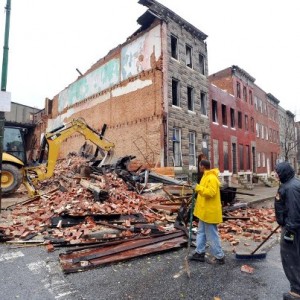
Baltimore avoided major damage from Hurricane Sandy, especially in comparison to more seriously affected communities on Maryland’s Eastern Shore, New Jersey and New York. Unfortunately, the storm did result in damage to at least a few of our city’s historic buildings and landscapes: four vacant rowhouses collapsed in West Baltimore’s historic Harlem Park neighborhood and the storm uprooted a storied Osage Orange tree in Druid Hill Park believed to be around 400 years old.
The Maryland Historical Trust is working to gather information about properties affected by this disaster so if you own a historic property that sustained damage please visit the MHT Hurricane Preparedness and Disaster Recovery page and fill out a Hurricane Damage Report form to alert MHT staff to your property’s condition. MHT plans to use these forms for recovery efforts and work in consultation with both FEMA and MEMA to help connect property owners with recovery resources as they become available.
The Maryland Historical Trust has also prepared an Historic Structures Emergency Assessment Form for available for download as a Microsoft Word Document that you can use to assess and inventory damaged historic resources in Baltimore or around the region. Finally, rehabilitation tax credits are available through MHT for qualified projects and FEMA will likely have low interest loans available. Baltimore Heritage also offers our own resources, including regular workshops, to help home-owners learn more about city and state historic tax credit programs. The Maryland Historical Trust is working to identify other available resources to help with damage recovery costs and will make the information available as soon as possible.
